A Living Herb Wreath (As Seen in Farmers Almanac)
DIY Herb Wreath Tutorial
By Mary Beth Gullickson
Enjoy the aroma, flavor, and beauty of thriving herbs in a decorative form.
This wreath of culinary herbs is designed to hang or be placed outside where it gets sun for 4 to 5 hours each day. Plan to put it in a place that is easily accessible so that you can cut sprigs on a regular basis.
The best herbs for this wreath have shallow roots and a low-growth pattern, with woody stems (these help the plants to maintain their shape). Soft-tissue herbs, such as basil or cilantro, tend to break easily when planted in the wreath and are not likely hold up to wind. Recommended herbs are thyme, creeping rosemary, tarragon, creeping mint (all varieties), and marjoram. Plant a mix of these or plant the wreath entirely with one herb. (You can experiment with other herbs in a larger wreath form, but do not exceed 20 inches in diameter or it will be too heavy to hang.)
Supplies
Most of the necessary supplies can be found at garden and craft supply stores. Allow about 2 hours to make a wreath, not including time required to soak the moss.
- 15 yards wax coated twine (do not use wire)
- 14-inch wire wreath frame, preferably slightly curved (not flat) to hold moss in place
- 8 quart bag of organic Espoma sphagnum moss or 6×6-inch Supermoss compress cube of sphagnum moss, soaked for 4 hours in water so it is spongy and loose
- 1 large Popsicle stick to wrap twine around
- 5 3-1/2-inch pot-size herbs, young but rooted out, wet
- Scissors
- Work space that can get wet and dirty
- Gloves (optional; they can make tying the twine difficult)
Instructions
1. Wrap the twine onto the stick so it covers the whole stick; this will keep it flat and not bulky. With the wreath frame curve facing you, tie the twine to the wreath’s outer ring. This is where you will plant your first herb.
2. Take a handful of moss and spread it onto the wire frame about 1 inch thick and 5 inches wide; this will support the base of the plant.
If you like, use the plant id tarragon the frame to remember what is planted and to help hold the moss in place until you tie the plant down.
3. Remove one plant from its pot. Carefully tear the wet root ball down the middle, leaving 3 inches of root mass on each side, retaining as much soil as possible. Place the root ball on the sphagnum moss you just placed on the frame. Spread out (like a butterfly) and flatten the plant’s roots on top of the moss. Completely cover the soil and root with more wet sphagnum moss.
TIP: If your plants come in a fiber or coco mat pot, tear the coco mat pot into flat pieces and put the pieces between the wire frame and sphagnum moss before setting the plant into the moss. The coco mat will help to hold the moss in place and add extra stability.
4. Wrap the twine in a “z” pattern around the root ball: Wrap the twine twice close to the left side the herb crown, attaching plant and moss to the frame, then pull slightly to tighten. Wrap the twine through the middle of the plant crown and around the moss and frame one time. This will hold the herb in place securely but not so tightly that the roots can not grow. Wrap the twine twice around the right side of the plant roots, moss, and frame. Tie the twine in a double knot on the back of the outer frame. ( Wrapping each herb separately will enable you to replace one of the herbs later, if necessary, without rewrapping the entire wreath.)
Do not cut the twine. This will be wrapped all around the frame to secure all plants before cutting. Use plenty of moss to cover the entire root mass, this is the plants’ growing medium.
Pick up wreath and shake it ever so slightly. The plant should not fall off or apart. If it is loose, use more twine and tie tighter. This might take practice, but after the first one you’ll get it.
5. Next to the mound holding your first herb, pack fistfuls of moss on the wire frame until it is about 3 inches thick and covers 4 inches of frame. You will not put an herb here; this is space for the herbs to grow and will keep the wreath the same thickness all around. Wrap the twine in a Z pattern several times around just moss to the wire frame as a space between plants.
Tie off, as directed, then shake the wreath to make sure it is secure. Repeat steps 2 through 4 for each remaining herb. Use plenty of moss to cover.
When all the plants and moss are set, wrap twine counter-clockwise in a z pattern to add extra strength to the structure and hold any loose ends in place.
Tip: Pull twine slightly after each wrap around a plant. It should be taut but loose enough for roots to push through. Tie the twine and shake the wreath after each plant to be sure it will hold up to hanging.
Care
- To keep the plants healthy, water by soaking the wreath, then hanging it in sunlight for 4 or more hours. (If the wreath is in full sun all day, you will need to water more often.) Let the moss dry slightly between watering. Check the wreath daily. On hot, sunny days it may need more water.
- Use organic liquid fertilizer every two weeks when soaking. (I recommend Espoma grow food. Use the suggested rate on the bottle.
- If desired, allow plants to get long and secure them to the wreath with a hairpin.
- Cut herbs weekly for cooking and to keep compact. Cutting produces new grow and keeps the plants healthy and strong.
Enjoy the creation and bounty of your craft!

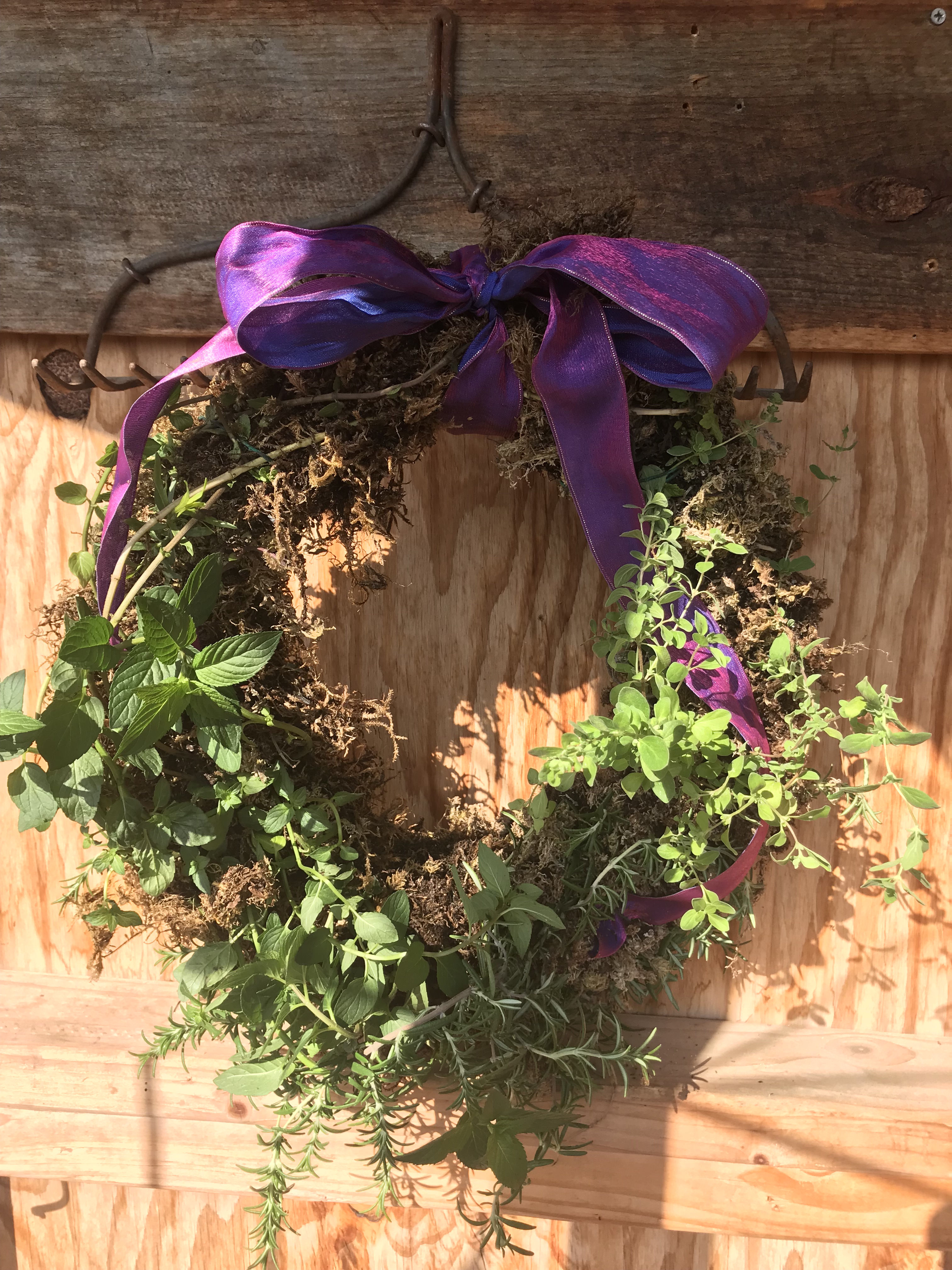

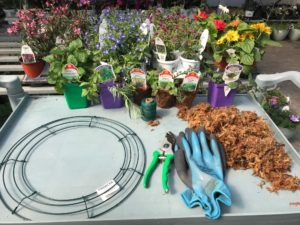
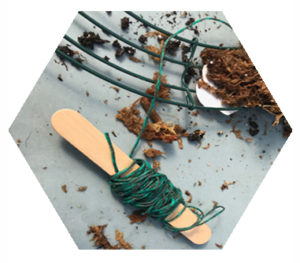
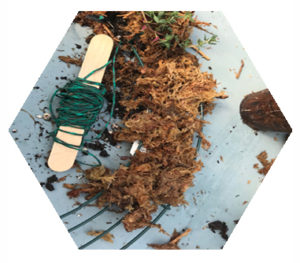
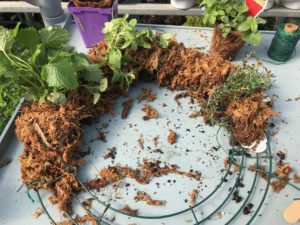
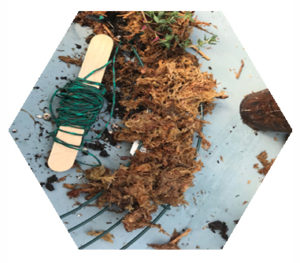
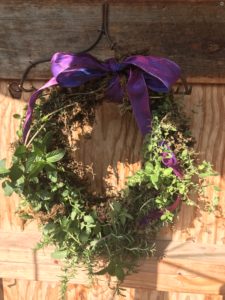
No responses yet